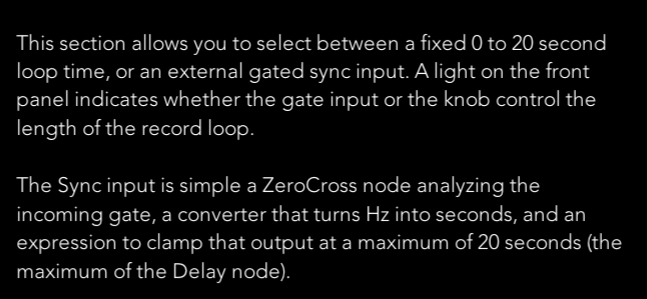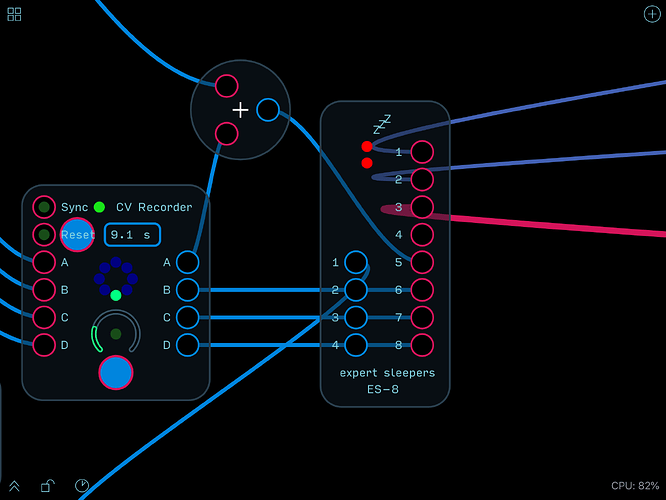Slightly off topic, but it reminded me of this module.
Then I’m coming to Audulus 4, too))) Faders and Fedor, hahahahah)
Fedorable. 
Can someone possibly slap together a version that has a gate record built in? I will but you a coffee. 
Added a multichannel version (see first post) - depending on what you want each channel to do, you need to do some fiddling. It explains it inside, but if you want to do gates, you have to attach an x>0 expression to the output, if you want to do modulation, you have to attach an LPF at the output, and if you want to do 1/oct, you just need to directly connect it.
The place you’re looking for is here:
This default is set up to do two channels of 1/oct and gate.
Christmas came early!
Thanks so much. Send me your email and I will grab you a coffee.
I think it should have a thru (or whatever you call it), so that you can send pulses through when not recording, but also when you have something recorded and looping it would be nice to be able to still pass gates/trigs through.
What do you mean?
Oh just think of a use case when recording loops. You don’t want to loose your bypass on your looper when you record. Just as you don’t want to have to record in order to hear what you are playing.
Sorry my head is in three places. I am trying to get my elektron A4 to clock mBrane so I can clock the ES-8 which could then clock the CV Recorder.  Yarns is a bit unintuitive.
Yarns is a bit unintuitive.
Just want some clarification on the sync input for the Multichannel CV Recorder.
I am using midi syncs (yarns). I have a master clock and a transport. The way things are working, I have one signal that divides the measures and one that keeps time. From what I understand, the signal that divides measures seems to be what I would want to connect in order to communicate the total loop length, whereas what the clock signal gives me is a bpm.
On the MC CV Recorder module there is a sync and a reset. I am having a hard time getting my head around how to have the right length to match bars. Or, rather, fiddling with the “seconds” dial on the multi version seems like I should be quantizing it somehow.
The sync input measures the time between gate pulses and sets that as the length of the loop. You’ll have to send it a division that is X bars of your master clock quarternote or whatever it is. Make sense?
This is what throws me. Can it calculate bpm based on two pulses ten seconds apart?
- okay so in thinking about this point. Yes, bpm does need a tight range. Two pulses ten seconds apart assumes finite divisions of the total length, but there are still multiples of divisions available. 60, 120, 240…
It doesn’t seem to perform any editing of the length when you give it a reset (in some way it some how does though, maybe)?
- The reset resets the stopwatch. In thinking about this, it seems it might all be my problem. Or that it is only a matter of the display circle not completing itself perfectly.
One of my assumptions is that a sync needs to be fairly frequent, but I am guessing.
It feels like when it gets external quantization, it should snap the total seconds into the display or something. What it appears to do is show that the loop is being either under or over calculated.
- Maybe having a dial that just showed ratios instead would be better?
All you’d need to do to add the type of sync you’re talking about is to plug in a 16th note to the sync input and then multiply the output of the zerocross node by 16 and then by however many measures you want it to be.
Yarns is pretty mainstream. It provides 16th note syncs (you can actually set the clock divider input and output divisions).
I think it might help if you said why I should follow the second part of the directions. Are you saying I need to understand how to implement a strategy to divide time?
but why? Not that I shouldn’t, I just don’t comprehend. It’s like a mechanic saying, “you want more horsepower right?” and you say yeah, then she gives you a strategy. In this case I am not sure we both have the same thing in mind – ie. horsepower.
- Okay my brain is still going. The zero cross node preforms the operation that I am trying to communicate. So I just need to learn to use it properly, like I logic function, etc. Nodes are modular modules and I need to step up and learn more.
- The zero cross simply preforms an ‘if, then’. If this amplitude, then pulse; where in this case, the signal would be bipolar and the special case would be any time the threshold of 0 is crossed.
- In order to apply this to time, seconds need to be in hertz. Or rather, somehow, we can derive and generate a pulse from another pulse. (must be how my multimeter works)

That almost sounds like if I turn the knob off, it will perform the operation automatically. But it might be describing the original smaller module that had a gesture knob.
Just insert an expression node between the zero cross and whatever the next node is and do seconds x 16 x 8 for 8 bars of looping. You won’t get more than 20 seconds since that’s the max of the delay node.
That’s vague to me. But maybe I’ll let it sit for a while.
The zero cross node outputs the time between pulses in seconds. If you put a 16th note in there, you need 16 times the length of a 16th note to create one bar of looping time. If you then have 1 bar, you can multiply that by 8 to get 8 bars of looping time.
Trying to work through it. Simple tasks in foreign languages are funny. What is the purpose of having a looper that doesn’t snap the clips to bar divisions?
I am always looking at hardware guitar pedal loopers thinking, “do I have to buy the giant one in order to have a midi sync input.”
It was just how I designed it when I first made it. The only design flaw is that you have to wait a few bars before you can start using it, but how often are you starting to perform a patch 8 bars after you open the patch initially? Whenever I add it to the new library I’ll probably just add this new way of syncing in.
yeah sorry, all I am trying to do is make music, and I can’t run my es8 and audulus with a daw, so I keep hitting this brick wall of creativity where I want to play my digital synth keyboard and I can’t record it. Every week I get a bit closer.


